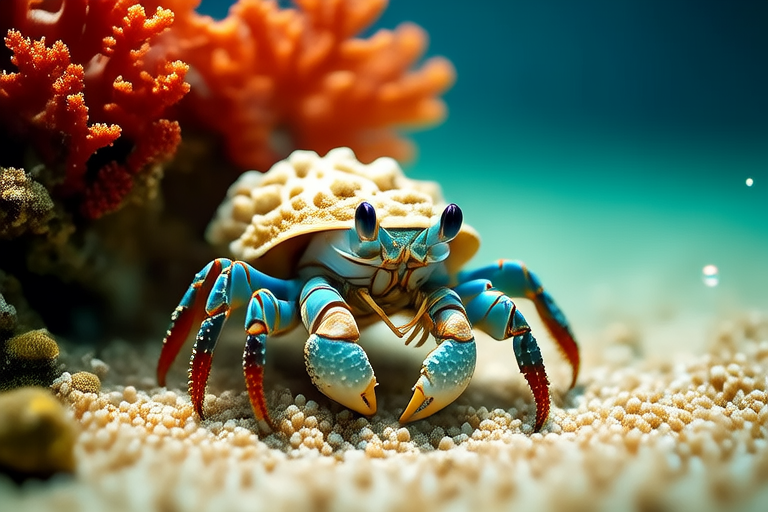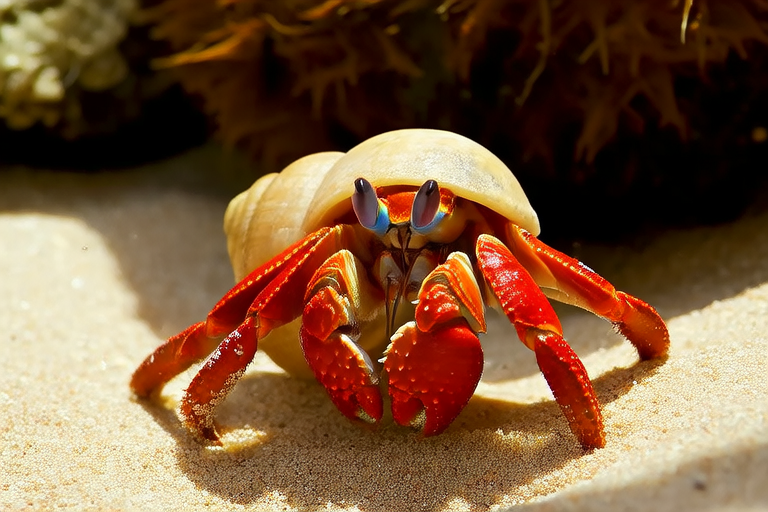
The Fascinating World of Hermit Crabs
Hermit crabs are among the most intriguing creatures in the animal kingdom, known for their unique behaviors, habitat preferences, and care requirements. These small crustaceans have garnered significant attention from both marine biologists and hobbyists alike due to their distinctive characteristics and the challenges they face in their natural habitats.
Unique Behaviors and Habitat Preferences
Hermit crabs are perhaps best known for their habit of living inside discarded mollusk shells. This behavior is a result of their soft, vulnerable abdomens that require protection. As hermit crabs grow, they outgrow their current shell and must find a new one. This shell-changing process is crucial for their survival and can be observed as a fascinating behavior. When a hermit crab finds a suitable shell, it will often inspect it thoroughly before making the switch. The process of moving into a new shell is not just about finding a larger space; it also involves ensuring the shell’s integrity and suitability for the crab’s specific species.
Hermit crabs are highly adaptable creatures, capable of thriving in various environments. They are commonly found in coastal areas, mangrove forests, and coral reefs. Their ability to live in diverse habitats is largely attributed to their flexible diet and the presence of numerous potential shell hosts. However, while hermit crabs can adapt to different environments, they still require specific conditions to thrive. For instance, they need access to clean water, a steady supply of food, and an abundance of suitable shells.
Social Dynamics Within Colonies
Contrary to popular belief, hermit crabs are not solitary animals. They often live in large colonies, where they engage in complex social interactions. These interactions include communication through touch and chemical signals, which play a vital role in maintaining group cohesion and cooperation. In some cases, hermit crabs have been observed working together to move larger shells or share resources. This level of social interaction underscores the importance of understanding hermit crabs’ colony dynamics for effective conservation efforts.
Nocturnal Activities
Hermit crabs are primarily nocturnal, meaning they are most active during the night. This behavior helps them avoid predators and take advantage of cooler temperatures. During the day, they often remain hidden in their shells or seek shelter in crevices and under rocks. Their nocturnal lifestyle has contributed to the development of specialized sensory organs, such as highly sensitive antennae, which help them navigate their environment in low light conditions.
Dietary Needs and Adaptation to Different Environments
Hermit crabs are omnivorous, feeding on a wide range of foods including algae, dead plant matter, and small invertebrates. Their diet varies depending on their location and the availability of resources. For example, those living in coral reefs may consume more algae, while those in mangrove forests might rely more heavily on fallen leaves and fruits. This flexibility in diet allows hermit crabs to adapt to different environments and survive in challenging conditions.
In captivity, hermit crabs can be fed a variety of foods, including commercial hermit crab food, fruits, vegetables, and protein sources like fish flakes or shrimp. It is important to provide a balanced diet and ensure that any food items are appropriate for the specific species being cared for. Additionally, fresh water and saltwater should be provided regularly to maintain hydration and support overall health.
Symbiotic Relationships
Hermit crabs form symbiotic relationships with several species of marine life. One notable example is their relationship with sea anemones. The anemone attaches itself to the outside of the hermit crab’s shell, providing camouflage and additional protection against predators. In return, the anemone benefits from the mobility and increased access to food that the hermit crab provides. Another example of symbiosis is the relationship between hermit crabs and certain species of algae, which grow on the exterior of their shells. This algae not only aids in camouflage but also contributes to the crab’s diet.
Conservation Efforts and Threats to Natural Habitats
Despite their resilience and adaptability, hermit crabs face numerous threats in their natural habitats. Human activities such as coastal development, pollution, and overfishing have significantly impacted the ecosystems where hermit crabs live. Additionally, the pet trade has led to a decline in wild populations as demand for hermit crabs as pets continues to rise. Conservation efforts focus on protecting critical habitats, reducing pollution, and promoting sustainable practices in the pet industry. By raising awareness about these issues and supporting conservation initiatives, we can help ensure the survival of hermit crabs and the ecosystems they inhabit.
Why Hermit Crabs Deserve More Attention and Appreciation
Hermit crabs are fascinating creatures that offer valuable insights into the complexities of marine life. Their unique behaviors, social dynamics, and adaptation strategies make them worthy of further study and appreciation. By understanding and respecting hermit crabs and their habitats, we can contribute to their conservation and promote a healthier marine ecosystem. Whether you’re a marine biologist, hobbyist, or simply someone interested in nature, taking the time to learn about hermit crabs can deepen your appreciation for the intricate web of life in our oceans.




